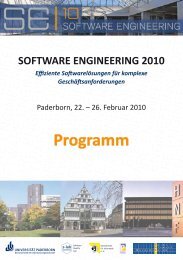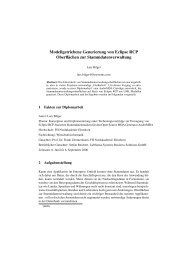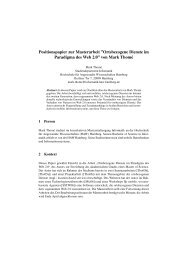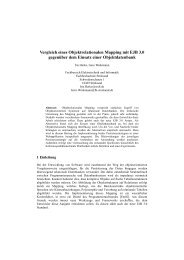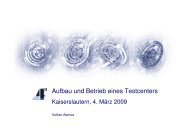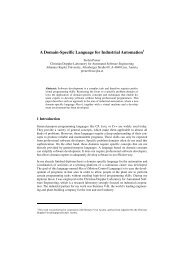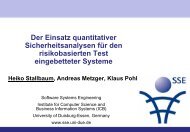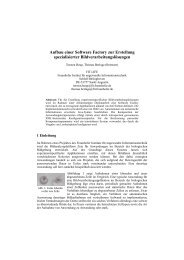Programmheft - Software Engineering Konferenzen
Programmheft - Software Engineering Konferenzen
Programmheft - Software Engineering Konferenzen
Erfolgreiche ePaper selbst erstellen
Machen Sie aus Ihren PDF Publikationen ein blätterbares Flipbook mit unserer einzigartigen Google optimierten e-Paper Software.
Donnerstag<br />
11:00–13:00 (Session G2)<br />
Hörsaal B<br />
Applying the ISO 9126 Quality Model to Test<br />
Specifications – Exemplified for TTCN-3 Test<br />
Specifications<br />
Ein Forschungsbericht von Benjamin Zeiss, Diana<br />
Vega, Ina Schieferdecker, Helmut Neukirchen, Jens<br />
Grabowski<br />
Quality models are needed to evaluate and set<br />
goals for the quality of a software product. The<br />
international ISO/IEC standard 9126 defines a<br />
general quality model for software products.<br />
<strong>Software</strong> is developed in different domains and<br />
the usage of the ISO/IEC quality model requires<br />
an instantiation for each concrete domain. One<br />
special domain is the development and maintenance<br />
of test specifications. Test specifications<br />
for testing, e.g. the Internet Protocol version 6<br />
(IPv6) or the Session Initiation Protocol (SIP),<br />
reach sizes of more than 40.000 lines of test<br />
code. Such large test specifications require strict<br />
quality assurance. In this paper, we present an<br />
adaptation of the ISO/IEC 9126 quality model to<br />
test specifications and show its instantiation for<br />
test specifications written in the Testing and Test<br />
Control Notation (TTCN-3). Example measurements<br />
of the standardised SIP test suite demonstrate<br />
the applicability of our approach.<br />
Towards Organization-Oriented <strong>Software</strong> <strong>Engineering</strong><br />
Ein Forschungsbericht von Matthias Wester-Ebbinghaus,<br />
Daniel Moldt, Christine Reese, Kolja<br />
Markwardt<br />
<strong>Software</strong> systems are subject to ever increasing<br />
complexity and in need of efficient structuring.<br />
The concept of organization as an expressive<br />
and abstract realworld reference presents<br />
a promising starting point. In the field of computer<br />
science, organizations have particularly<br />
been studied within the multi-agent systems<br />
community. However, the individual agent metaphor<br />
turns out to be of rather small granularity<br />
and somewhat less suited for large-scale software<br />
systems. To overcome this problem while<br />
preserving the earnings of the agent-oriented<br />
approach to software engineering, this paper<br />
introduces the new metaphor of organizational<br />
unit. This concept allows to summarize a set of<br />
units in a manner that complex systems may<br />
be regarded and treated as wholes and exhibit<br />
corporate agency. According to different levels<br />
of analysis drawn from organization theory, different<br />
types of organizational units are incorporated<br />
into a reference architecture for organization-oriented<br />
software engineering.<br />
Ist Programmieren ein Mannschaftssport?<br />
Mathias Pohl, Michael Burch, Peter Weißgerber<br />
Die Analyse der Check-In-Informationen von<br />
Open-Source-<strong>Software</strong>-Projekten, die unter Versionskontrolle<br />
stehen, kann wichtige Einsichten<br />
über das Programmierverhalten von <strong>Software</strong>-<br />
Entwicklern liefern. Da eine Aufteilung der Entwickler<br />
aufgrund der Aufgabenverteilung in<br />
jedem Projekt vorliegt, muss die Entwicklung<br />
untereinander koordiniert verlaufen.<br />
In diesem Papier werden drei Visualisierungstechniken<br />
vorgestellt, mit deren Hilfe untersucht<br />
werden kann, ob Programmierer wirklich<br />
als Team arbeiten oder ob sie getrennt voneinander<br />
<strong>Software</strong> entwickeln. Desweiteren<br />
können Stagnationsphasen in der Entwicklung<br />
aufgedeckt werden, die auf mögliche Probleme<br />
hindeuten.<br />
Um die Nützlichkeit dieser Visualisierungstechniken<br />
zu demonstrieren, werden Fallstudien an<br />
den Open-Source-Projekten JUNIT und TOM-<br />
CAT3 durchgeführt. Dabei können interessante<br />
Verhaltensmuster ausfindig gemacht werden,<br />
wie zum Beispiel die Spezialisierung eines Entwicklers<br />
auf ein bestimmtes Modul. Außerdem<br />
21



